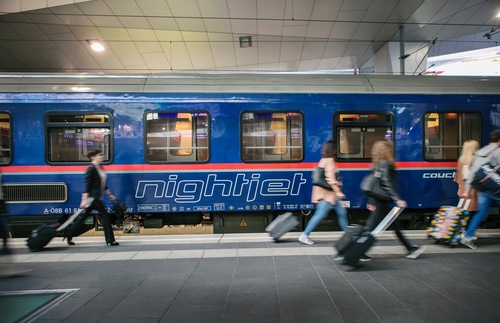
The highly anticipated new sleeper route connects London to Berlin in just 16 hours, becoming one of Europe’s most eagerly awaited capital-to-capital journeys
In the beer gardens of Berlin, night trains are a popular subject of discussion, rivaling even the strategies for gaining entry into the renowned Berghain nightclub (where advice like “being a single man, looking ‘alright,’ and not smiling” is given).
At Prater Biergarten, the oldest beer garden in the German capital, I reunite with a friend while enjoying pilsners and pretzels injected with butter. As I mention my intention to embark on the inaugural European Sleeper journey to Brussels, which is widely celebrated as one of the most anticipated routes in the night train renaissance, my friend reveals his plans to board the same train next month. He confesses feeling remorseful about taking numerous flights lately and seeks a more environmentally friendly alternative. Additionally, he mentions the allure of unwinding and indulging in libations while aboard a night train
The thriving revival of sleeper trains owes much to heightened environmental consciousness, along with a shift in perception that views leisurely overland journeys as enjoyable rather than merely tolerable. Austria’s Nightjet has expanded its services to encompass 25 European cities, while France’s Midnight Trains plans to introduce luxury sleeper trains to 10 destinations next year.
European Sleeper’s route from Brussels to Berlin operates three times a week in both directions, making stops at Amsterdam and Rotterdam. Remarkably, this new service by the Dutch-Belgian startup marks the first direct overnight train connection between the capital cities of Belgium and Germany in over a decade
Nowadays, one can conveniently embark on a two-hour Eurostar journey from London’s St Pancras station to Brussels-Midi station on a Friday afternoon, followed by catching the evening European Sleeper departing from the same Brussels station. By doing so, it’s possible to reach Berlin in time for breakfast. When departing from Berlin on Sunday night, one can once again transfer to Eurostar in Brussels and arrive in London by Monday lunchtime, having experienced a complete weekend of Berlin’s cultural vibrancy or exhilarating chaos
Ahead of embarking on the inaugural journey from Berlin, I fully immerse myself in the city’s reputation as the capital of hipsters by staying at the newly opened Selina Mitte hotel, where dorm beds start at €50 and rooms at €98. The hotel’s lobby features a curated selection of vinyl records and vintage clothing for sale, while the bar even offers tattoo services. However, instead of indulging in these offerings, I opt to spend my euros on delectable, towering cinnamon buns from the nearby Zeit für Brot bakery. Berlin may very well be the epitome of coolness, as even the bakery staff exude a catwalk-ready appearance while bagging €8 loaves of bread
However, my visit to Berlin coincides with the unveiling of a replica of the Pillar of Shame, a poignant sculpture created by Danish artist Jens Galschiøt to commemorate the 1989 Tiananmen Square massacre. This event showcases Berlin’s significant artistic influence and its role as a central hub for human rights activism. I observe Uyghur and Tibetan activists painting red faces on the statue, yet the atmosphere among the crowd wielding paintbrushes is one of hope rather than horror. The monument will remain adjacent to the Axel Springer building until June 22nd.
Prior to boarding the European Sleeper, I embark on a pilgrimage to the residential block where David Bowie and Iggy Pop resided during the late 1970s, as well as their local café, which has since transformed into Neues Ufer, a vibrant gay bar adorned with paintings of Bowie and graffiti tributes in the restrooms. With anticipation, I arrive at Gesundbrunnen station to greet the European Sleeper, which is set to depart at 21:11 (although it will later primarily depart from Hauptbahnhof, it currently uses Gesundbrunnen occasionally due to track maintenance).
The arrival of the European Sleeper, powered by an electric NS Class 86 engine, is met with excitement akin to a film premiere. Train enthusiasts, passengers, journalists, YouTubers, and officials from the transport ministry cheer and applaud as the carriages come to a stop. Back on Track members, advocates for night trains as an alternative to air travel in tackling global heating, proudly wave flags proclaiming “TRAINS NOT PLANES!” amidst the clattering of the train’s arrival
Joining the train are Chris Engelsman and Elmer van Buuren, the founders of European Sleeper. Engelsman’s fondness for night trains was ignited during his travels across Russia when he was younger. “It offers a cozy and adventurous experience,” he explains. “We anticipate attracting individuals who have a passion for train travel, who enjoy the sense of adventure, and who prefer to avoid the stresses associated with airports. It’s about simply relishing the journey itself
According to Engelsman, the European Sleeper is not positioned as a luxury service, and he offers a pragmatic perspective on the absence of air conditioning in the train’s mid-range couchette carriages, which interestingly enough are the most sought-after ticket option. “You have the option to open the windows,” he explains. “It provides a more enjoyable way of traveling, with a touch of romance.”
Despite the fact that a round-trip train journey from London to Berlin can cost at least €250 for a combination of European Sleeper couchettes and Eurostar seats, many passengers prioritize the allure of rail travel and its inherent romance over any concerns about cost. Comparatively, one can occasionally find a Ryanair flight from Stansted to Berlin for a return fare of £50
While the train departs from Gesundbrunnen, I encounter Lisa Marie and Stefanie, passengers who opted for a six-seat cabin after their flight to London was canceled. Lisa Marie, a student, expresses her appreciation for the ambiance on the train, stating, “I really enjoy the atmosphere. I’m even considering doing this more often. It’s more environmentally friendly, and it’s also enjoyable. You simply hop on, find a seat, and relax—it’s that simple



